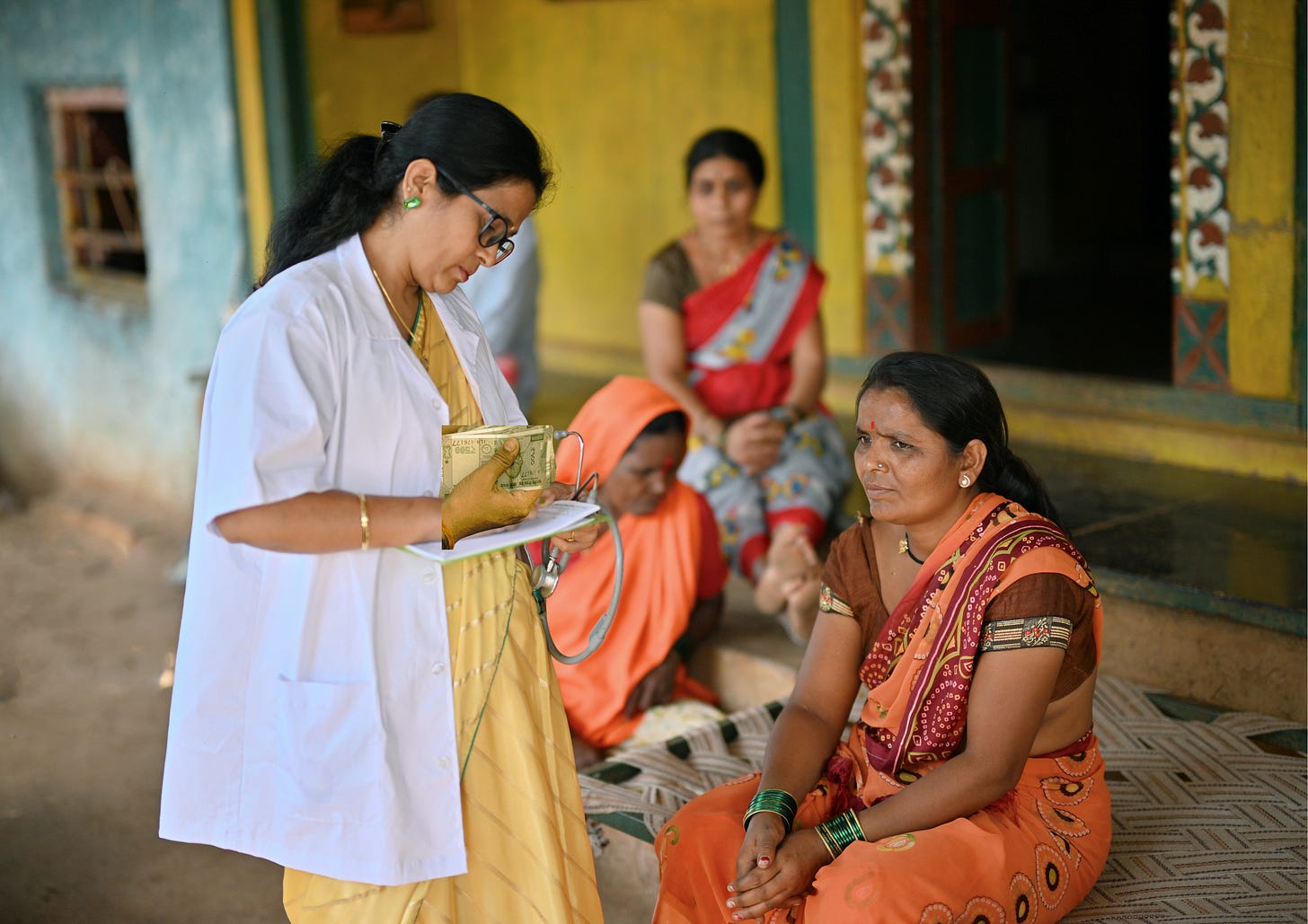India’s Maternal Health: Why Cash and Care Must Go Together
Small transfers and advice drove dramatic gains in institutional births; now administrative slippage risks undoing progress.
View as PDF
Vidya Mahambare, Great Lakes Institute of Management
Sowmya Dhanaraj, Good Business Lab
Vibhu Jain, KPMG Global Services
Vivek Jadhav, Institute of Management Technology
SDG 3: Good Health and Well-Being | SDG 16: Peace, Justice and Strong Institutions
Institutions: Ministry of Health and Family Welfare | Ministry of Women and Child Development
India has achieved one of the most remarkable public health shifts of the 21st century. In 2005, fewer than one in four births in the country’s poorest states took place in hospitals. By 2019-21, nearly nine in ten did. The key driver of this change was not a vast new hospital network or an army of doctors but something more modest: small cash payments to mothers who chose institutional delivery, as shown in recent analysis using the National Family Health Surveys (NFHS-4 and NFHS-5) data.
Known as conditional cash transfers (CCTs), these payments were introduced under the Janani Suraksha Yojana (JSY). The principle was straightforward: cover the costs that deter families from seeking care – such as transport or lost wages – and combine this financial nudge with health advice from frontline workers. Accredited Social Health Activists (ASHAs), Auxiliary Nurse Midwives (ANMs) and Anganwadi workers became the link between households and public facilities, offering guidance on antenatal check-ups, safe delivery and newborn care.
The results were immediate. Institutional deliveries surged, maternal complications were treated sooner, and infant survival rates improved. By global standards, the scale was striking.
Coverage is Slipping
Recent years, however, tell a different story. In 2015-16, nearly 71 percent of mothers giving birth in public health facilities reported receiving JSY; by 2019-21, the figure had fallen to 55 percent. Among the poorest households and mothers with no schooling – the very groups most in need - less than half received support.
A supplementary programme, the Pradhan Mantri Matru Vandana Yojana (PMMVY), offers smaller transfers during pregnancy. Yet here too, performance is uneven. Barely 5.3 percent of mothers delivering in public facilities accessed PMMVY as of 2019-21, while in states like Bihar and Uttar Pradesh fewer than half of eligible women benefited. Many mothers now miss out on both programmes – a significant gap in design and delivery that is avoidable.
At the same time, the composition of support has shifted. The share of mothers receiving both cash and advice has risen only modestly in 2019-21, while those receiving cash alone have fallen sharply and those receiving advice without cash have nearly tripled. Advice on its own risks weak effects: families may know what to do but lack the means to act.
Cash Plus Care Saves Lives
Evidence from more than 84,000 mother–child pairs show why these gaps matter. Mothers receiving both CCTs and health advice had significantly lower neonatal mortality (deaths within 28 days of birth) and infant mortality (deaths within the first year) compared to those receiving neither.
The effect was strongest for mothers with no education, families in the lowest income categories, and households belonging to scheduled caste and scheduled tribe communities. For them, the mix of financial support and timely guidance narrowed the gaps that have long defined health inequality in India.
Cash alone was effective in bringing women to hospitals, but not in changing everyday practices such as breastfeeding, immunisation and hygiene. Advice alone, meanwhile, offered modest gains but often failed to translate into survival because households lacked the means to act. It is the combination of cash plus care, that delivers the largest and most equitable health impact.
Budgets Underspent, Mothers Underserved
Much of the decline is rooted in administration rather than intent. Budget execution has lagged in states that need support the most. In Bihar, JSY funds utilisation fell from 69 percent of approved budgets in 2020–21 to just 63 percent in 2021–22. In Uttar Pradesh, the fall was steeper: from 84 percent to only 54 percent. Beneficiary numbers were also underestimated – by 12 per cent in Bihar and as much as 32 per cent in UP – creating shortfalls even where funds were technically available.
The COVID-19 pandemic added strain, but the persistence of under-spending after 2020–21 points to deeper administrative weakness: delays in fund release and inadequate monitoring, which together leave persistent gaps at the last mile.
Design choices compound these challenges. PMMVY currently provides ₹5,000 for the first child, regardless of gender, and ₹6,000 for the second child if the baby is a girl. The aim is to encourage safe deliveries and promote the value of daughters. But in practice, it risks excluding many mothers and reinforcing parental preference for first-born sons. Every birth carries risk, and every child deserves support. Restricting benefits by birth order or gender undermines the equity principle that gave JSY its legitimacy.
Frontline Advice - The Missing Piece
Even where design is inclusive and budgets are adequate, outcomes depend on frontline advice. By 2019-21, three-quarters of mothers receiving cash transfers reported some form of guidance, up from just over half in 2015-16. Advice on institutional delivery rose from 42 to 66 percent. These are encouraging gains.
Yet the content and quality of advice remain inconsistent. Training and supervision need strengthening, with a sharper focus on preventing diarrhoea and respiratory infections – the leading killers of young children in India. Simple, practical messages such as how to prepare oral rehydration salts, how to initiate breastfeeding within the first hour of birth, and why immunisation matters can transform outcomes if consistently delivered.
Five Lessons for policymakers
First, restore coverage. Transfers must again reach at least seven in ten mothers delivering in public facilities, especially focusing on those from poorer backgrounds, as they once did.
Second, lift restrictions. Eligibility rules tied to birth order or gender should be scrapped, ensuring every mother and child is supported.
Third, fix implementation. Budgets must be released on time, tracked transparently, and matched to realistic beneficiary numbers. Direct benefit transfers and real-time dashboards can close the gap between allocations and access.
Fourth, integrate cash and care. Transfers and advice must flow together, not in isolation. Regular public reviews should show who benefits – broken down by caste, education and wealth – so that those most in need are not quietly excluded.
Finally, move beyond survival. Monitoring must track not only mortality but also nutrition, immunisation and early childhood development. These outcomes will determine not only whether children live, but whether they thrive.
None of this is beyond reach. Transfers are relatively low-cost compared with building hospitals or hiring specialists. They empower households directly, giving women a measure of financial agency at a critical stage in their lives. When paired with timely advice, they remain among the most cost-effective tools for advancing health and equity.
The Policy Choice
India’s maternal cash transfers have already altered the trajectory of public health. Two decades ago, they nudged families into hospitals, setting off a chain of improvements in maternal and child survival. The challenge today is not whether they work, but whether the country sustains their promise.
Allow coverage to slide further, and inequities will widen again. Restore and strengthen the programmes, and India can consolidate one of its most important social investments. The lesson from the past is plain: modest cash, paired with timely advice, can change the future of an entire generation.
View as PDF
Authors:

The discussion in this article is based on the authors’ research published in Indian Growth and Development Review (2025). Views are personal.


